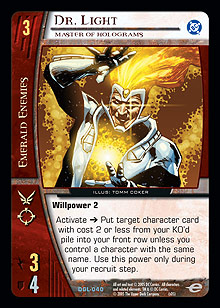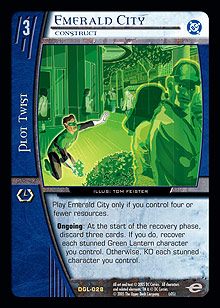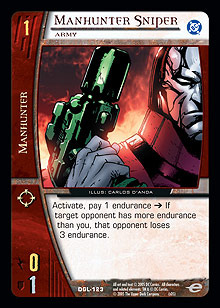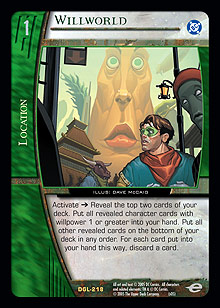
Since the Avengers previews will soon start to appear in full force, I thought I’d take this chance to look back at some of the Green Lantern Corps cards that caused the most deliberation during development. In addition to a few anecdotal stories, I’ve included one card from each team and one generic card that received considerable attention as we fixed up the set.
Dr. Light, Master of Holograms
 Let’s start off with a card that already has much notoriety—none other than Dr. Light. In the first incarnation of the card that I received from Danny, Dr. Light brought his holograms out in a very temporary fashion: “Activate >>> Put a character card from your KO’d pile with a cost of 2 or less into your front row. At the start of the recovery phase, KO that character.” While Dr. Light is currently underpowered stat-wise for a 3-cost character, the earliest version showed Danny’s concern for the power level of this type of effect with a measly 3 ATK and 2 DEF. This version of the card was especially interesting in that it could put out characters at a moment’s notice to attack or defend. While these one-shot effects were fun, we eventually found grander schemes for the card.
Let’s start off with a card that already has much notoriety—none other than Dr. Light. In the first incarnation of the card that I received from Danny, Dr. Light brought his holograms out in a very temporary fashion: “Activate >>> Put a character card from your KO’d pile with a cost of 2 or less into your front row. At the start of the recovery phase, KO that character.” While Dr. Light is currently underpowered stat-wise for a 3-cost character, the earliest version showed Danny’s concern for the power level of this type of effect with a measly 3 ATK and 2 DEF. This version of the card was especially interesting in that it could put out characters at a moment’s notice to attack or defend. While these one-shot effects were fun, we eventually found grander schemes for the card.
You’ve likely heard us mention that we will be experimenting with ways to encourage off-curve builds. Well, a couple of weeks into developing the file, Dr. Light looked like a good candidate for pushing the power level on such things. How problematic would it be for a character to bring out small characters on later turns of the game, especially if the character doing so was underpowered stat-wise and would have to forgo attacking to do so? We wanted a card that would be a strong motivating factor in encouraging players to include lots of small characters in their decks. We wanted a card that could bring back characters that had been lost through attrition. And so the Doctor took his nearly final form: “Activate >>> Choose a character card in you KO’d pile with a cost of 2 or less. You may recruit that character card as though it were in your hand and without paying its recruit cost.” This version also had his current stats.
It wasn’t necessarily part of our design that he would exploit ways of putting character cards into your KO’d pile, but we were open to exploring this area. We liked the way he interacted with cards like Goldface. I should also note here that one of the most powerful enablers for KO’d pile filling in this set came with a final re-write on a card I will discuss later in this article. Ultimately, the working version of Dr. Light confined us in the same way as early versions of Witching Hour had, since some characters in multiples (such as Beast) are particularly scary. We had determined the overall power level of Dr. Light was high enough that we didn’t want it to be too trivial to get out characters, so we made the final alteration to the card to prevent you from putting out characters already in play. In that way, we hoped players would diversify who they might bring out or find ways to get a character off the board in order to bring it back again. There were trade-offs in having characters put into play rather than being recruited. For example, this final change enabled a number of other options, such as exploiting small characters with loyalty or other recruiting restrictions. On the whole, these restrictions seemed like interesting options and we didn’t feel that they would take away too many areas of design space from us.
Emerald City
 In the course of a normal game of Vs. System,you expect there to be characters heading to the KO’d pile left and right. When I saw a card in the file for the Green Lantern team that might prevent you from ever losing a character throughout an entire game, I knew there would be some trouble. The original version of Emerald City was “Play cardname only during the build phase. Ongoing: At the start of the recovery phase, discard two Green Lantern character cards. If you do, recover each stunned character you control. Otherwise, KO each stunned character you control.”
In the course of a normal game of Vs. System,you expect there to be characters heading to the KO’d pile left and right. When I saw a card in the file for the Green Lantern team that might prevent you from ever losing a character throughout an entire game, I knew there would be some trouble. The original version of Emerald City was “Play cardname only during the build phase. Ongoing: At the start of the recovery phase, discard two Green Lantern character cards. If you do, recover each stunned character you control. Otherwise, KO each stunned character you control.”
The fact of the matter was that discarding two cards a turn wasn’t all that challenging in a deck with some reasonable card drawing. At times, it wasn’t especially hard to pull off for enough turns to win the game, even in a deck that wasn’t crafted to support the discard. Admittedly, you would still take a lot of breakthrough and stun endurance loss as normally occurs, so the card wouldn’t really have locked an opponent out of the game. The card would only help you maintain a very strong board presence at a fairly high cost. One of the problems with this sort of analysis was that the very first file also had Hal Jordan, Reborn, who in most any similar incarnation would be scary with Emerald City. This held especially true since the original playtest Hal Jordan, Reborn had a willpower of 7 and only required 12 willpower in play for his game-preserving effect. Later in testing, it was cards like Nero, Qwardian Puppet that were the most problematic . . . at least before we team stamped the characters that Nero was able to KO.
The first change to Emerald City was to give it the following text: “Play cardname only while you control four or less resources. Ongoing: At the start of the recovery phase, discard two GL Corps character cards. If you do, recover each stunned character you control. Otherwise, KO each stunned character you control.”
This changed forced a player to flip the card up early and put an investment into that particular strategy, rather than simply use the card to hold on at the end of a game. We quickly changed the card so that there were no restrictions on which cards you could choose to discard, since the card was already team-stamped and that really made it hit-or-miss on turns when you didn’t draw character cards.
Meanwhile, we were doing extensive testing with some of the card drawing effects in the set, such as Birthing Chamber and Central Power Battery, and we found that they could readily supply the cards that this deck needed to win. Amongst other things, until the very end of development, Birthing Chamber did not require a discard in its effect when you had six or more characters. Also, Willworld was part of the problem until that card was altered (see below). Besides the card drawing capabilities in the set, the Green Lantern team was already becoming a force of its own with the likes of Arisia and G’Nort, especially once Olapet received her boost (another story we’ll get to shortly).
In the end, after Justin Gary built countless variants of decks using Emerald City, we discovered that the power level of those decks was just too high once Emerald City was flipped. So we stepped things up another notch with a requirement of three discards. After that, the decks were still strong, and we had at last created the tension we’d originally wanted.
From Qward with Hate
 The initial version of From Qward with Hate quite possibly scared me more than any other card in the set. Danny is a staunch defender of card ideas; if I try to dismiss an idea, he’ll tell me that there is some way to balance it. The initial card didn’t have a threshold specified, but its game text was as follows: “You may KO two resources and two characters you control. If you do, each of your opponents KO’s a resource and a character he controls.”
The initial version of From Qward with Hate quite possibly scared me more than any other card in the set. Danny is a staunch defender of card ideas; if I try to dismiss an idea, he’ll tell me that there is some way to balance it. The initial card didn’t have a threshold specified, but its game text was as follows: “You may KO two resources and two characters you control. If you do, each of your opponents KO’s a resource and a character he controls.”
Even assuming that this card almost certainly couldn’t be allowed to function in your recruit step (if you have the initiative, it is pretty amazing in the correct deck) and was restricted to the combat phase, there were still a number of issues. I was hesitant to make a card like this at all. Why? It is a complete wrecking ball against an on-curve deck, especially against ones without character search cards. If you set up things correctly, you could KO two little army characters and force your opponent to lose a more sizeable character. And in all likelihood, you’d force him or her to miss a reasonable drop on the following turn for lack of another character at the same drop. Meanwhile, you’d likely come out just fine on the next turn, assuming you’d built this into a nice off-curve deck. While this scenario is what often arises as a result of Ka-Boom! or Foiled!, and those are generic effects, there is some room to play around those cards. In the case of the working version of From Qward with Hate, you couldn’t do much to play around it except make it painful for the opponent to KO two characters. Furthermore, Ka-Boom! and Foiled! push the limits on what I’d consider to be reasonable effects.
The first change to the game text immediately became that of the final card, though the card was tested for a long time with a threshold of 5. At that threshold, the card still created some of the scenarios about which I was worried. Specifically, a player using a curve deck could be prevented from ever playing characters of cost 6 or more. And there was exceedingly little a player could do to play around the card. At the final threshold of 6, the card could still keep some players off of their late games, but it forced the Anti-Matter player to keep out the expendable characters longer and gave the opponent a little more time to establish a board presence and draw enough cards to play off-curve characters following a surprise From Qward with Hate.
Manhunter Sniper
 The initial version of Manhunter Sniper was: “Activate >>> If target opponent has more endurance than you, that opponent loses 3 endurance.”
The initial version of Manhunter Sniper was: “Activate >>> If target opponent has more endurance than you, that opponent loses 3 endurance.”
Just about every topic under the sun was argued when it came to this card. Would the Manhunters be viable without any 1-cost characters that had an ATK greater than 0? Should we give the Sniper 1 ATK? There was a camp who wanted to force the Manhunters to play their game in another way than the usual, and another camp who felt they should have the same “outs” as the other teams in terms of having the little guys get on team-attacks and so forth. After some deliberation, we decided that we would leave it with a 0 ATK and keep the power level of the effect as strong as was reasonable.
We very much liked the play pattern that these guys created, especially with Highmaster, who could inflict the final blow via other cards in the team that filled the KO’d pile. Between those cards and the Manhunters’ capacity to spew out 3-cost characters, the team had quite a different feel than the other teams out there.
The final change to the Sniper—requiring payment of a point of endurance—was largely to help get the ball rolling on the endurance race. It also helped to make sure that a player could still overcome the huge swarm of Snipers that we routinely saw at the very end of games.
Willworld
 The first game text attached to the name Willworld bore no resemblance to later versions. Initially, it was what probably transitioned into Rain of Acorns, and then it became a huge attack pump for willpower “that never was” (think +X ATK and +X DEF with a sizeable drawback). That card was scrapped, only to re-emerge a couple of weeks later with the following game text: “Activate >>> Choose a number. Reveal cards from the top of your deck until you reveal a character card with willpower greater than the chosen number. Put that character card into your hand and shuffle the revealed cards into your deck. Lose endurance equal to the number of cards you revealed.”
The first game text attached to the name Willworld bore no resemblance to later versions. Initially, it was what probably transitioned into Rain of Acorns, and then it became a huge attack pump for willpower “that never was” (think +X ATK and +X DEF with a sizeable drawback). That card was scrapped, only to re-emerge a couple of weeks later with the following game text: “Activate >>> Choose a number. Reveal cards from the top of your deck until you reveal a character card with willpower greater than the chosen number. Put that character card into your hand and shuffle the revealed cards into your deck. Lose endurance equal to the number of cards you revealed.”
We were hoping that this card would create some interesting scenarios in which a player would build a deck with a clever spread of characters at various willpowers so that he or she could get to appropriate characters on appropriate turns. Maybe we weren’t creative enough with our decks, but the problem was that this was a very powerful card that let you convert endurance into character cards in hand from the outset of the game. Everyone using this card nearly always chose “0” as their number. So while it was a huge reward for sticking only to character cards with willpower, the actual choice of what number to name was not really interesting. This took a lot away from the card. Willworld still clung onto its spot in the file as a power card for willpower builds until Patrick Sullivan complained about its power level one too many times. In any two similar decks facing off, the player who drew Willworld seemed to be at a decisive advantage. It was a hard advantage to calculate because the endurance had to be taken into account, but the advantage was real.
We wanted the final version of the card to fulfill a similar role of getting to characters with willpower, but we didn’t want the card to generate too much card advantage. Danny latched onto the idea of a Cerebro for willpower characters. And so we had Willworld, but only after telling Danny he was stupid for repeatedly insisting that it should fetch construct cards as well.
Boost
I’m a big fan of the boost mechanic. At some point in development, I usually harass the game designers into adding boost to the cards in the set. Common cards with short game text are the most likely candidates. It tends to get put on common cards because they play a prominent role in Sealed Pack, and boost plays a more significant role in Sealed Pack play than in Constructed because Sealed Pack decks tend to have fewer ways to hit a precise curve. Boost winds up on cards with shorter text because, well, there is space. The problem is that we also like cards that have short game text for their simplicity and elegance. A compromise of sorts was established in Marvel Knights and continued in Green Lantern Corps with cards whose only text is their boost text.
Danny is a big fan of simple cards. As the file was heading into late stages of development, there were a mere six cards in the set with boost. I’d cluttered up cards in the past like Forager, Mongul, and Brainiac with boost late in the development process, and I’d seen to it that other cards received some boost effect. This time around, I put Andrew Yip to work slipping boost into the set past Danny’s watchful eyes. I know several of his ideas made it through, including the boosts on Olapet and Guy Gardner, Green Lantern. In the end, only one of the initial six boosts in the set made it through to print, but Andrew and I got Danny to push the final boost count up to twelve.
And with that, I’ll leave you in anticipation of the Avengers previews. But before I do, I’ll make note that boost in Avengers is used sparingly in favor of another similar mechanic.
Comments are welcome at DHumpherys@metagame.com.